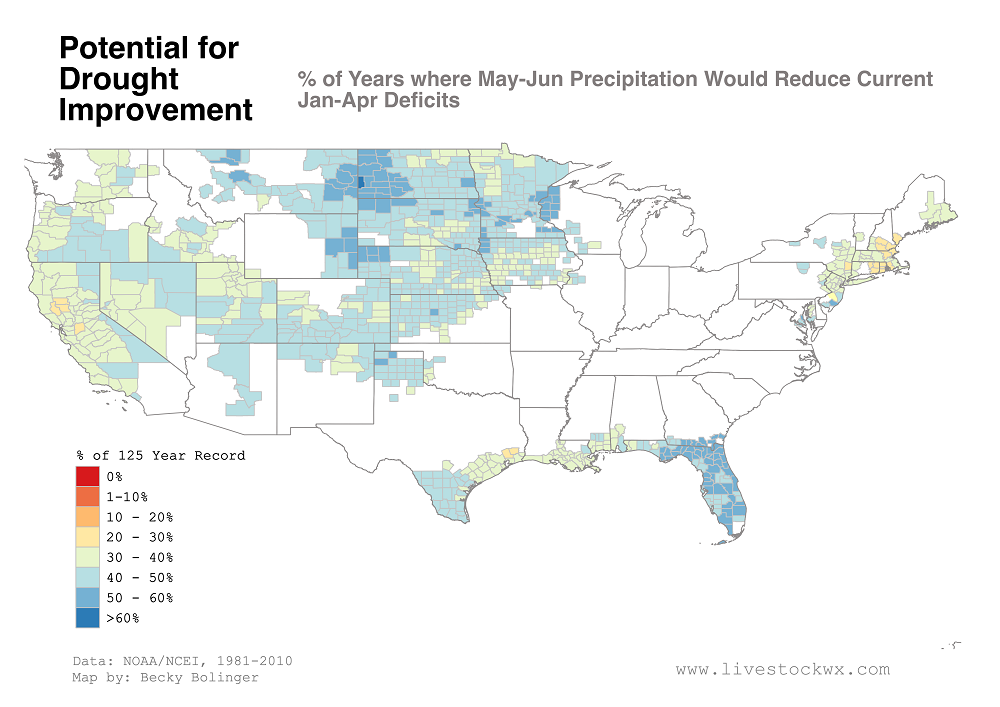
May 29, 2020
A longer version of this article first appeared on Livestock Wx (click here for original article) and was written by Dr. Becky Bolinger. Dr. Bolinger is the Colorado assistant state climatologist and is based at Colorado State University. She is a frequent contributor to Livestock Wx, the U.S. Drought Monitor and tracks all things climate.
Jan-Apr Precipitation Deficits
One of the most basic definitions of drought is a deficit of precipitation over an area. Because each location of the world has its own unique climate, we have to consider what’s “normal” for a location to assess if there’s a deficit over a time period.
Using county precipitation data, subtracted from the average for the 1981-2010 time period, the map below shows counties with a precipitation deficit greater than half an inch from January through April 2020.

Some widespread areas with deficits to note are along the West Coast, the northern High Plains, and along the Gulf of Mexico. Some of the largest increases in the intensity and a real extent of drought have been in southeast Colorado, western Kansas, the eastern half of New Mexico, and the Texas-Oklahoma Panhandle. Unfortunately, familiar territory for drought.
Much of these areas have seen deficits ranging from half an inch to four inches. This may not seem like a lot, but the impacts of these deficits have included drying soils and slowed growth as grasslands come out of dormancy.
Chance of Drought Improvement: What History Tells Us
For the Central U.S., May and June rank as two of the top three wettest months of the year. West of the Continental Divide, though, they’re actually transitioning to their dry season. Based on the current precipitation deficit map above, we wondered how likely those areas that are either in their dry or wet season could make up those deficits from earlier in the year? In other words, if you are entering into your wet season does that mean drought will almost always improve, while if you moving into your dry season, does that mean drought will most likely get worse?
Let’s take a look…

The above map shows for every county that currently has a January-April precipitation deficit, the percent of years where the May-June precipitation could help reduce or improve that deficit. For example, 30-40% of the time (using the entire historical record: 1895-2019), counties shaded in light green have received greater than average precipitation in May-June months. So, not only did they get what is normal for May-June, they got more to offset the deficit in 30-40% of the years.
Counties shaded in light or dark blue, more than 50% of the time, they were able to get enough to reduce a deficit. You can see there is a higher percentage of years that reduce deficit coinciding with the wet season locations. And dry season locations have a lower percentage of years that reduce deficits in May-June.
In the next map, we’re comparing the extent of the current deficit (Jan-Apr 2020) to the percent of years in the record that got their normal May-June precipitation, in addition to the at least the amount of the current deficit. In other words, if your county had a two inch deficit, and your May-June normal is four inches, you’d have to get six inches to eliminate the deficit. How often does that happen in May-June?
Many counties in the central portion of the country have had 20-40% of years where the May-June total could eliminate the current deficit. There are even a few counties with a 40-50% shot. Unfortunately, for many counties in Colorado and to the west, the percent of years that can eliminate the deficit is low. For Southeast Colorado, this is partly due to how large the deficits are. The deficits are big enough that it is harder to eliminate. As you move west, the issue becomes the amount you can possibly get in May-June when those months are not typically a wet time of year. For counties shaded in gray (a few in southwest Colorado and most of California), there are no years in the record where May-June precipitation could eliminate the deficit. Basically, there is no chance (based on our 125-year record) of deficit elimination at this time.

So, we’re most of the way through May. How are these areas doing? The below 30-day precipitation map shows green areas that have received greater than average precipitation for May and orange/red areas have received less than average precipitation. As you can see a large part of the TSCRA region are seeing deficits of 1-2”. Elimination of the drought over the next month in these areas is not impossible but historically, the probabilities are relatively low. For parts of southern Colorado elimination will be almost impossible, however.

Over the last 10 days we’ve seen some decent moisture over the Central U.S. which should help those Jan-Apr deficits. The short-range outlooks are not providing a lot of encouragement, unfortunately. The 6 to 10 and 8 to 14 day outlooks are favoring hot and dry conditions for most of the TSCRA region.
As for the month of June, there’s a lot of uncertainty about what could possibly happen. For areas in a deficit, it’s likely that you will experience some hot and dry days. And, as is typical with summer, expect thunderstorms to boost moisture in some locations and skip out on other locations
